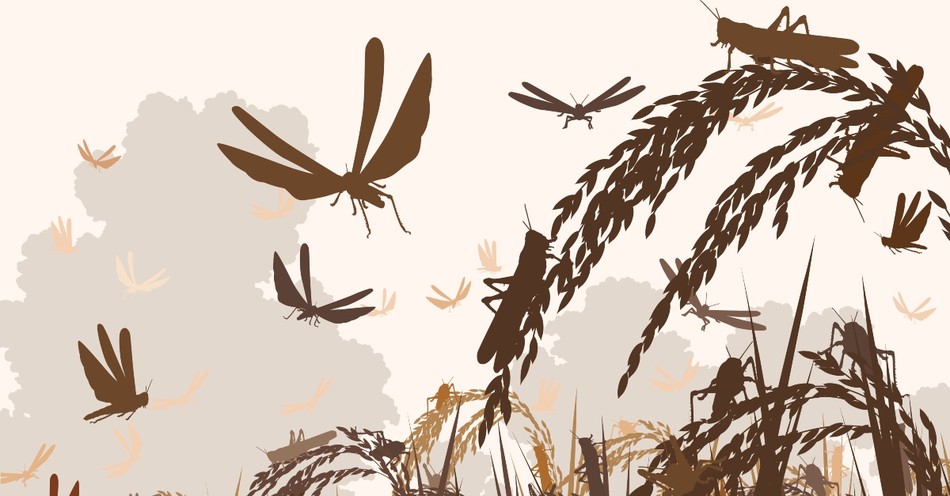I think the year was 1985. I came up with that year from a bit of research. My memory is fuzzy because I was only a little boy at the time. Yet, I still remember an invasion of periodical cicadas.
We called them locusts — even though technically, they are a different species. I remember them being loud and annoying and my uncles being moderately worried about their crops that year.
That’s the memory that I take into the Bible when I read about a plague of locusts. So, when I read a prophet like Joel or think of the plague of locusts in Exodus 10, my first thought is something like, “Oh, that must have been really annoying.”
This is one of the dangers that we have as we read Scripture. We might be using the same word, but those words have a different meaning.
In the Bible, a locust plague is very different than what I experienced in my fuzzy memory of the 1980s. They were devastating. And they were symbolic of something even greater.
How Destructive Are Locusts?
I thought locusts were only noisy and annoying. I was wrong. Part of the problem was that we were calling cicadas — which are known for their loud sound — and are very different than locusts. Cicadas aren’t as destructive as locusts. Locusts are devastating.
The desert locust, which is likely the type of locust we read about in the Bible, consumes its own body weight (2g) each day.
That doesn’t sound like much — but when you realize they come in massive swarms, those numbers start to add up. Swarms have been known to cover more than 400 square miles. And each swarm can teem with as many as 100 million locusts per square mile.
Do a little math. A hundred million multiplied by 400 square miles comes to 40 billion locusts eating two grams per day. That is about 176 pounds that they eat each day.
If they were people-eaters instead of consumers of vegetation, they would eat 1.7 million people per day. And if that isn’t enough, their excrement is toxic and destroys whatever they do not eat.
Again, locusts are devastating. Consider Joel 2:3, “The land is like the garden of Eden before them (so beautiful, rich, plentiful, glorious) but a desolate wilderness behind them (meaning that this devastation is so massive that all is laid bare). This devastation, though, often points to something even greater.
Where Do We Find a Plague of Locusts in the Bible?
The first time we see a plague of locusts is in Exodus. In Exodus 10, the eighth plague is a plague of locusts.
Moses warned Pharoah that if he didn’t let the Israelites go, God would bring a massive swarm of locusts upon their land. Pharoah didn’t yield, and we see a few verses later what happened as a result:
They covered the face of the whole land, so that the land was darkened, and they ate all the plants in the land and all the fruit of the trees that the hail had left. Not a green thing remained, neither tree nor plant of the field, through all the land of Egypt (Exodus 10:15).
There is another devastating plague of locusts in the Book of Joel. Some question whether or not this is actually a plague of locusts or if Joel is referring to the coming Assyrian invasion.
Personally, I think it’s a bit of both. There is an actual plague of locusts, which points to the invasion of the Assyrians — which points to the judgment of God. Joel also speaks of their destruction:
Hear this, you elders; give ear, all inhabitants of the land! Has such a thing happened in your days, or in the days of your fathers? Tell your children of it, and let your children tell their children, and their children to another generation. What the cutting locust left, the swarming locust has eaten. What the swarming locust left, the hopping locust has eaten, and what the hopping locust left, the destroying locust has eaten (Joel 1:1-4).
There is a similar picture given in Jeremiah of locusts as a metaphor for an invading tribe. Locusts serve as an apt picture of a military, a tightly banded group swarming for the purpose of devastation.
It’s a similar picture that is also given in Revelation 9. Though there is some difference here, the symbolism is pointing to something similar.
Each of these plagues tells a story and points to something even greater than a plague of locusts. What do we learn from each of these plagues of locusts?
What Is its Meaning in Exodus?
In Exodus, God is showing his power to both the Egyptians and to the Israelites. What happens in the plague is a reversal of the blessings of creation. God can give beauty and riches, and He can take those away.
It is a display of his sovereignty. So, what we have in the plague of locusts is just one among many pictures that shows the unraveling of all that the Egyptians hold dear. God is making Himself known.
I appreciate how Ligon Duncan says this:
“What’s happening in Exodus, chapter 10 is that God is now removing that creational provision and blessing from Egypt. He’s de-creating and deconstructing Egypt. In the judgment of God, all the blessings of creation are reversed.”
What Is its Meaning in Joel?
Some will say that the locust plague in Joel isn’t a plague of locusts at all, but rather that God is using something they would know (a locust plague) to warn them of something they had not seen before, a devastating invasion from the Assyrian army.
There is some truth to this. I believe the locust plague is real, but it’s also pointing to the much greater devastation that will come through Assyria. But even that is not the main point. The locusts and the Assyrians point to something even greater.
The key is found in Joel 1:15, “Alas for the day! For the day of the Lord is near, and as destruction from the Almighty it comes.”
This is a play on words that Joel has been building up to through the first 15 verses. He goes to every class of people throughout the land and shows them the devastation brought about by locusts.
And he says something like, “See how these little insects brought you to your knees? You can’t endure a locust plague. What would happen if the Almighty was bent on destruction?”
The Hebrew word for destruction is shadad whereas the Hebrew word for the Almighty is El Shaddai. When Shaddai becomes bent on shadad what will happen? How destructive can El Shaddai be?
The point that Joel is making is that on the great and awesome day of the Lord, none will be saved.
It will be more devastating than locusts. It will be more devastating than the coming Assyrian invasion. The only refuge is to find safety in YHWH. Through repentance will come restoration.
What Is the Meaning for Us Today?
Joel was pointing to the great day of the Lord. He asks a penetrating question, “For the day of the Lord is great and every awesome; who can endure it?” The answer is simple.
No one. But the story of the Bible, thankfully, doesn’t stop there. The devastation of a locust plague is meant to push us toward seeking rescue.
We will not endure that day — our only hope is Joel 2:32, “And it shall come to pass that everyone who calls on the name of the Lord shall be saved. For in Mount Zion and in Jerusalem there shall be those who escape, as the Lord has said, and among the survivors shall be those whom the Lord calls.”
There is a bit more good news tucked away in Joel 2:25. God says, “I will restore to you the years that the swarming locusts have eaten.” God can restore the years that the locust has eaten.
This is where God is taking us. A locust plague is a picture of devastation and de-creation. But the good news of the gospel is that God overturns this and restores us to Eden — an even greater paradise than the original.
The meaning, then, for a locust plague (or any devastation) is to acknowledge our weakness, frailty, and dependence. Where repentance is needed, let us repent. And let us fly to Jesus for our refuge.
If we cannot stand before the devastation of created things — what makes us think we could stand against our Creator? Rather than running from Him, let us run to Him.
For further reading:
What Were the 10 Plagues that God Inflicted on Egypt and Is COVID-19 Similar?
What Is the Significance of the Promised Land in the Bible?
Why Did Moses Remove His Shoes in Front of the Burning Bush?
Photo Credit: ©iStock/Getty Images Plus/AdrianHillman
Mike Leake is husband to Nikki and father to Isaiah and Hannah. He is also the lead pastor at Calvary of Neosho, MO. Mike is the author of Torn to Heal and Jesus Is All You Need. His writing home is https://mikeleake.net and you can connect with him on Twitter @mikeleake. Mike has a new writing project at Proverbs4Today.

_639003522088907085.jpg)

